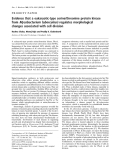
39
Journal of Medicine and Pharmacy, Volume 10, No.7/2020
Application of the resazurin microtitre assay for the detection of
isoniazid and/or rifampicin resistant Mycobacterium tuberculosis
clinical isolates in Central Vietnam
Nguyen Thi Binh Nguyen1, Paola Molicotti2, Tran Hung1, Le Thanh Phuc3,
Nguyen Thi Kieu Diem3, Nguyen Tan Chum3, Le Trong Thach4, Truong Van Hue4, Ngo Viet Quynh Tram5
(1) Infectious diseases and Tuberculosis Dept., Hue University of Medicine and Pharmacy, Hue University, Vietnam
(2) Department of Biomedical Science, Microbiology and clinical Microbiology, University of Sassari, Italy
(3) Da Nang Lung Hospital, Vietnam
(4) Central Hospital 71, Thanh Hoa province, Vietnam
(5) Microbiology Department, Hue University of Medicine and Pharmacy, Hue University, Vietnam
Abstract
Background: Drug resistant tuberculosis (DR-TB) remains a global health problem. The diagnosis,
treatment, and management of DR-TB are the major challenges to Vietnam National Tuberculosis Control
Program. One of the most important solutions for overcoming this problem is developing reliable and low-cost
methods, which have been proposed to Drug Susceptibility Testing (DST) to detect drug resistant tuberculosis.
The methods have to be reasonably simple so that they can be widely used in provincial Lung hospitals.
Thus, our team conducted this study with the aim to apply the Resazurin Microtiter Assay (REMA) as drug
susceptibility testing for detecting rate of phenotyphic isoniazid- (INH) and/or rifampicin- (RIF) resistance
of Mycobacterium tuberculosis (MTB) isolates in central Vietnam. Method: A total of 196 Mycobacterium
tuberculosis clinical isolates were tested by the REMA and the results were compared with those of BACTEC
MGIT 960 system. The REMA was performed in 96-well plates with the concentration of INH and RIF 1.00–
0.031 µg/ml for INH and 2.00– 0.061 µg/ml, respectively. A strain is considered resistant to INH if the MIC is ≥
0.25 µg/ml. A strain is considered resistant to RIF if the MIC is ≥ 0.5 µg/ml. Results: The REMA results showed
42 (21.42%) MTB isolates resistant to INH, 13(6.63%) MTB isolates resistant to RIF, among them there were
12 (6.61%) isolates resistant to both RIF and INH, which were categorized as multi-drug resistant tuberculosis
(MDR-TB). The excellent results of REMA were compared to those of the BACTEC MGIT 960 as the standard
method, the sensitivities for isoniazid and rifampicin were 100% for both, the specificities for isoniazid and
rifampicin were 99.35%, 98.92%, respectively. The positive predictive value (PPV) and the negative predictive
value (NPV) for INH resistance were respectively 100% and 99.49%. The PPV and NPV were respectively 100%
and 98.98% for RIF. The accuracies were 99.49% and 98.98% for INH and RIF, respectively. The REMA plate
method had the sensitivity of 100% and the specificity of 99.46%, and PPV and NPV of respectively 91.67%
and 100% for the identification of MDR-TB strains. Conclusion: Resazurin microtiter assay appears to be a
good alternative method for the determination of drug susceptibility testing in low-resource countries such
as Vietnam because this method is simple, reliable and inexpensive.
Key words: Tuberculosis, Mycobacterium tuberculosis, Resazurin Microtiter Assay, drug resistance.
Corresponding author: Nguyen Thi Binh Nguyen, email: ntbnguyen@huemed-univ.edu.vn
Ngo Viet Quynh Tram, email: nvqtram@huemed-univ.edu.vn
Received: 21/9/2020, Accepted: 28/10/2020
DOI: 10.34071/jmp.2020.7.6
1. INTRODUCTION
Tuberculosis (TB) is an old infectious disease,
caused by Mycobacterium tuberculosis (MTB).
However, the threat of tuberculosis to the
public’s health is increasing [1]. According to the
World Health Organization (WHO) in 2018, 10
million patients with TB and 1.5 million deaths
were attributed to the disease [2]. The human
immunodeficiency virus pandemic, multidrug-
resistant TB (MDR-TB), and extensive drug TB (XDR-
TB) have emerged as major obstructions in the
treatment and efficient control of disease, especially
in underdeveloped and developing countries [3].
The early and accurate detection of drug resistance
MTB plays an important role on using of appropriate
treatment regimens for the patient and preventing
the spread of DR-TB isolates in the population.
The standard agar proportion methods used for





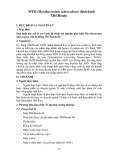
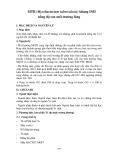

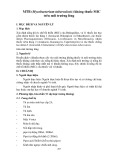
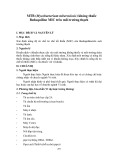
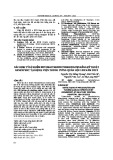
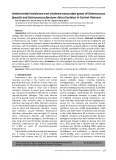
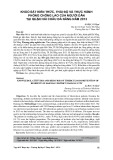

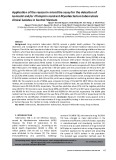
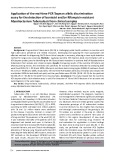

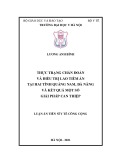
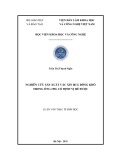
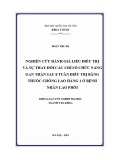
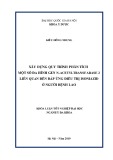
![Synthesis and anti-tuberculosis studies of 10-phenyl sulfonyl-2-alkyl/aryl- 4, 10 dihydrobenzo [4, 5] imidazo [1, 2-a] pyrimidin-4-one derivatives](https://cdn.tailieu.vn/images/document/thumbnail/2020/20200525/tocectocec/135x160/3621590394727.jpg)

